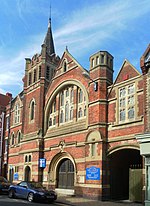Our Lady of Ransom Church, Eastbourne
1869 establishments in England19th-century Roman Catholic church buildings in the United KingdomChurches in EastbourneCommons category link is locally definedFrederick Walters buildings ... and 6 more
Gothic Revival architecture in East SussexGothic Revival church buildings in EnglandGrade II listed Roman Catholic churches in EnglandGrade II listed churches in East SussexRoman Catholic churches completed in 1903Roman Catholic churches in East Sussex

Our Lady of Ransom Church is a Roman Catholic Parish church in Eastbourne, East Sussex. It was founded as a mission in 1869, built from 1900 to 1903, and had extensions completed in 1926. It is situated on the corner of Meads Road and Grange Road, opposite Eastbourne Town F.C. in the centre of the town. It was designed by Frederick Walters and is a Grade II listed building.
Excerpt from the Wikipedia article Our Lady of Ransom Church, Eastbourne (License: CC BY-SA 3.0, Authors, Images).Our Lady of Ransom Church, Eastbourne
Grange Road,
Geographical coordinates (GPS) Address External links Nearby Places Show on map
Geographical coordinates (GPS)
| Latitude | Longitude |
|---|---|
| N 50.7661 ° | E 0.2777 ° |
Address
Our Lady of Ransom Catholic Church
Grange Road 2-4
BN21 4EU , Meads
England, United Kingdom
Open on Google Maps






